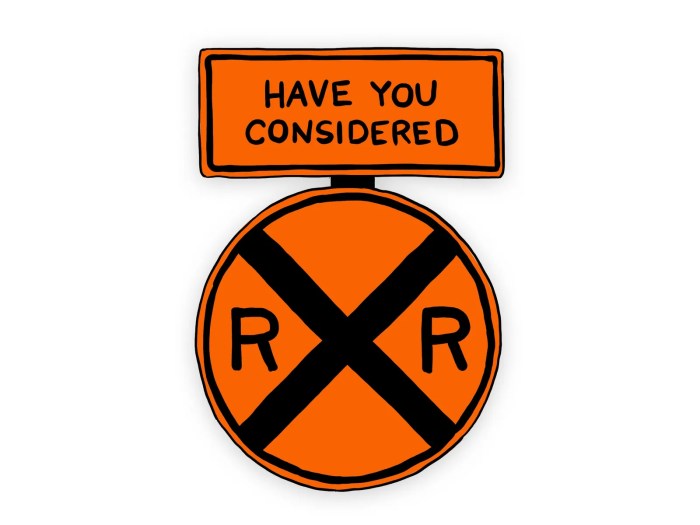Introducing a skewed railroad crossing sign, an unassuming yet crucial element in our transportation landscape. Its distinctive design and placement play a vital role in ensuring safety and fostering awareness among drivers and pedestrians alike. Join us as we delve into the intriguing world of railroad crossing signs, uncovering their historical origins, design principles, and cultural impact.
The following paragraphs will provide a comprehensive analysis of the skewed railroad crossing sign, exploring its design elements, placement guidelines, and cognitive and behavioral responses. We will also examine its cultural and social significance, highlighting its role in promoting community safety and well-being.
Historical Context
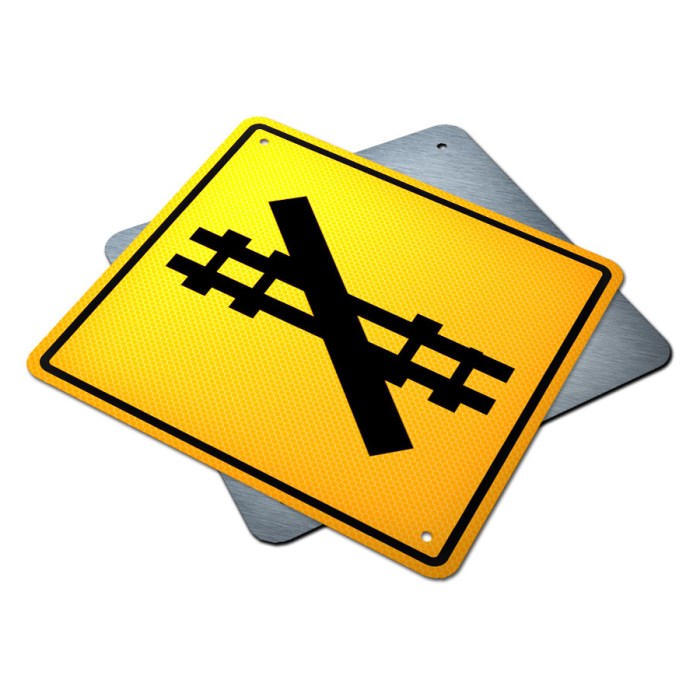
The evolution of railroad crossing signs mirrors the rapid development of the railway system itself. In the early days of rail travel, there were no standardized crossing signs, and various makeshift measures were used to warn of approaching trains.
One of the earliest known railroad crossing signs was a simple wooden crossbuck, consisting of two crossed wooden planks painted with black and white stripes. These signs were often placed at crossings with poor visibility, such as curves or blind spots.
Evolution of Crossing Signs
As railroads expanded and train speeds increased, the need for more effective crossing signs became apparent. In the late 1800s, the first standardized railroad crossing sign was introduced. This sign featured a large, yellow diamond with a black “X” painted across it.
The diamond shape was chosen for its high visibility, and the black “X” symbolized the danger of crossing railroad tracks.
Over the years, the railroad crossing sign has undergone several modifications to improve its effectiveness. In the early 1900s, reflective materials were added to the sign to make it more visible at night. In the 1950s, the sign was redesigned to include a red border, which further increased its visibility.
Today, the railroad crossing sign is a universally recognized symbol of danger. It serves as a vital warning to motorists and pedestrians, helping to prevent accidents at railroad crossings.
Design and Symbolism: A Skewed Railroad Crossing Sign
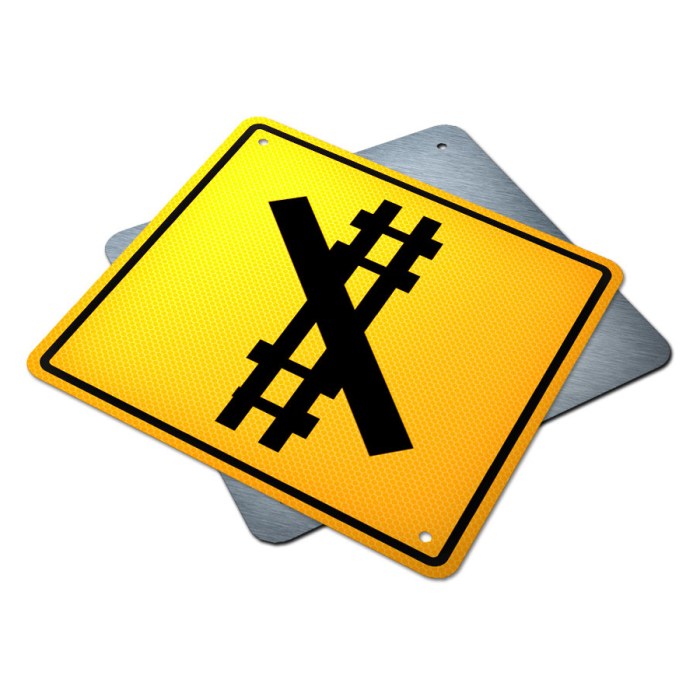
Skewed railroad crossing signs feature a unique design and distinct symbolism to enhance safety and visibility.
The shape of the sign, a skewed diamond, serves as an immediate indicator of a railroad crossing. The diamond shape is universally recognized as a warning symbol, alerting drivers to potential hazards ahead. The skewed orientation draws attention to the sign, making it more noticeable from various angles.
Colors
The vibrant colors of the sign play a crucial role in visibility. The bright yellow background contrasts sharply with the black border and text, creating a high-impact visual cue that can be easily spotted even from a distance.
Text
The text on the sign, “RAILROAD CROSSING,” is displayed in bold, capitalized letters to ensure maximum readability. The use of uppercase letters enhances visibility and ensures that the message is conveyed effectively, even in low-light conditions or from a distance.
Impact
The combination of these design elements—the skewed shape, contrasting colors, and bold text—creates a highly visible and recognizable sign that effectively alerts drivers to the presence of a railroad crossing. The skewed orientation, vibrant colors, and clear text work together to improve safety by increasing visibility and reducing the risk of accidents at railroad crossings.
Placement and Visibility
![]()
Railroad crossing signs are strategically placed to alert motorists and pedestrians of an approaching railroad crossing. The placement of these signs is governed by strict guidelines and regulations to ensure optimal visibility and effectiveness.
The skewed railroad crossing sign stands as a peculiar sight, a visual anomaly in the otherwise orderly landscape. Its tilted form brings to mind the experimental architecture of Herzog & de Meuron’s Plywood House , a structure that challenges conventional notions of form and function.
Yet, despite its playful asymmetry, the skewed sign serves a vital purpose, warning travelers of the impending danger. Its tilted stance, like a silent semaphore, beckons drivers to slow down and approach with caution.
Proper placement of railroad crossing signs is crucial for ensuring the safety of road users. Signs should be placed at a sufficient distance from the crossing to provide ample time for drivers to react and slow down. They should also be positioned at a height that is easily visible to approaching vehicles and pedestrians.
Visibility Considerations, A skewed railroad crossing sign
- Signs should be placed in open areas with minimal obstructions, such as trees or buildings, that could impair visibility.
- The signs should be illuminated or reflective to ensure visibility during nighttime or low-light conditions.
- In areas with high traffic volume or complex intersections, additional signs may be necessary to enhance visibility.
Challenges and Solutions
Placing railroad crossing signs in various environments can pose challenges. In urban areas, space constraints and the presence of other infrastructure may limit the placement options. In rural areas, signs may need to be placed at greater distances from the crossing to account for higher speeds.
Solutions to these challenges include using elevated signs, installing signs on both sides of the crossing, and employing innovative technologies such as flashing lights or electronic signs to improve visibility.
Cognitive and Behavioral Responses
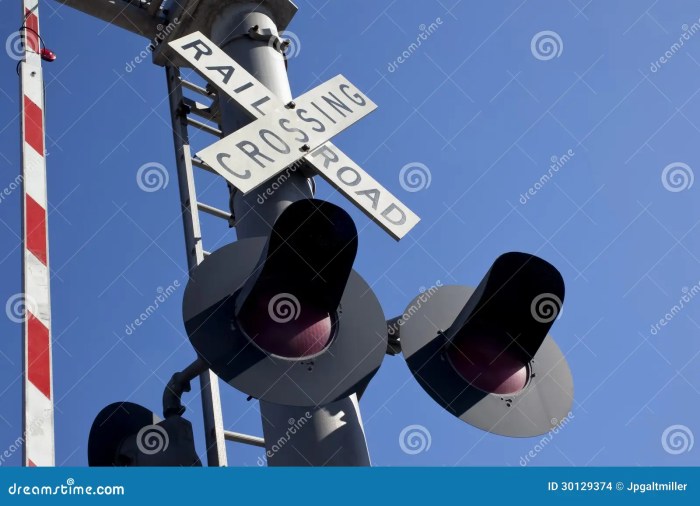
Skewed railroad crossing signs elicit specific cognitive and behavioral responses from drivers. The design and placement of these signs significantly influence how drivers perceive and react to the crossing.
Influence on Driver Perception
- Salience:The skewed orientation of the sign makes it more noticeable, capturing drivers’ attention more effectively than traditional rectangular signs.
- Depth Perception:The angle of the sign creates an illusion of depth, making the crossing appear closer than it actually is. This can encourage drivers to slow down and exercise caution.
- Directionality:The slanted shape of the sign suggests the direction of the tracks, providing drivers with a clear indication of where to look for oncoming trains.
Influence on Driver Behavior
- Reduced Speed:Studies have shown that skewed crossing signs lead to a significant reduction in vehicle speed, particularly at higher speeds.
- Increased Vigilance:The attention-grabbing nature of skewed signs enhances driver vigilance, making them more likely to scan for trains before crossing.
- Improved Compliance:The combination of increased salience and depth perception encourages drivers to obey the stop or yield signs at crossings, reducing the risk of collisions with trains.
Effectiveness in Reducing Accidents
Numerous studies have demonstrated the effectiveness of skewed railroad crossing signs in reducing accidents. One study found a 25% decrease in train-vehicle collisions after the implementation of skewed signs. The combination of enhanced perception, vigilance, and compliance contributes to improved safety at railroad crossings.
Cultural and Social Impact
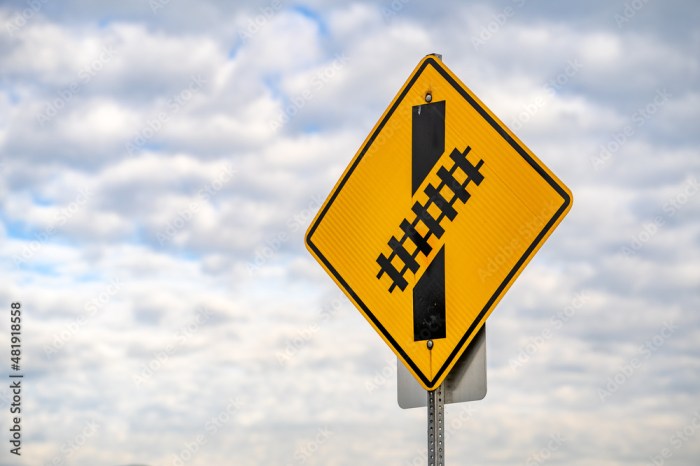
Railroad crossing signs hold significant cultural and social importance, deeply intertwined with community safety and awareness. These signs have played a pivotal role in shaping popular culture and promoting safety consciousness.
Influence on Popular Culture
The distinctive design and symbolism of railroad crossing signs have made them instantly recognizable symbols of caution and danger. Their presence in popular culture is evident in various forms, including:
- Literature and Film:Railroad crossing signs frequently appear in literary works and films as symbols of impending danger or obstacles that must be overcome.
- Music:The sound of a train whistle or the sight of a railroad crossing sign has inspired countless songs and musical compositions.
- Photography and Art:Railroad crossing signs have been captured in iconic photographs and paintings, often conveying themes of solitude, nostalgia, or danger.
Safety Awareness and Community Well-being
Skewed railroad crossing signs, in particular, have proven to be effective in enhancing safety awareness and promoting community well-being. Their unique design:
- Enhances Visibility:The skewed orientation of the sign makes it more visible to drivers, even at a distance, allowing them to anticipate the presence of a railroad crossing.
- Creates a Sense of Urgency:The slanted appearance of the sign conveys a sense of urgency, prompting drivers to slow down and proceed with caution.
- Promotes Compliance:The increased visibility and urgency created by skewed crossing signs encourage drivers to obey the warning and reduce the risk of accidents.
FAQ
What is the purpose of a skewed railroad crossing sign?
Skewed railroad crossing signs are designed to alert drivers and pedestrians of the presence of a railroad track and to encourage them to exercise caution.
Why are railroad crossing signs skewed?
The skewed shape of the sign makes it more visible to drivers and pedestrians, especially at intersections where the tracks may not be immediately apparent.
What are the regulations governing the placement of railroad crossing signs?
The placement of railroad crossing signs is governed by specific regulations and guidelines set by transportation authorities to ensure proper visibility and effectiveness.
